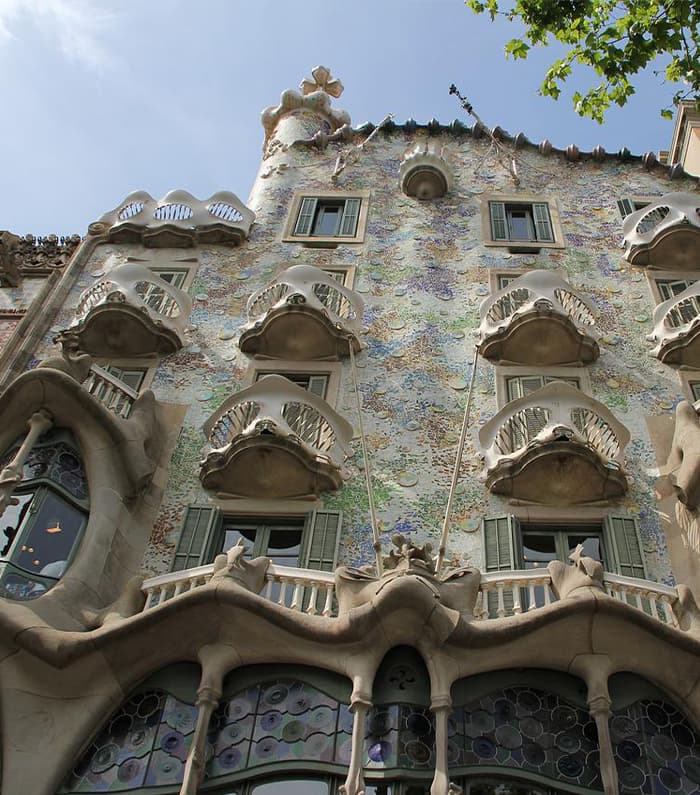Casa Batlló

You can hardly pass by this building while walking in Barcelona’s Eixample. At night, no chance at all. UNESCO was also flattered by the inclusion of the architectural “highlight” in the list of World Heritage Sites. The building is called “Batllo” or even “Batllo”, the correct variant is “Baglio”. From the first glance at the “House of Bones” (another name of the building) it is clear – Gaudi was here.
Interesting fact: next to the Baglio are two other unusual buildings, the Amalle and the Llio Morera. This trio is known as the “Quarter of Disagreement” because of its architectural fragmentation and singularity.
When the aforementioned Antoni Gaudi was working on the Park Guell, he was asked to “do something” with a house built in 1877 belonging to the wealthy Balho y Casanovas. The client planned to tear down the a priori walls and outshine its neighbors on Boulevard de Gracia.
He had the wrong person to ask with such requests! Gaudi still agreed to “outshine”, but decided to work with what he had. To defy him did not, by the age of 52 years old Antonio made a name for himself and the opinion of the architect was reckoned with. He said: Two new facades and a new decoration of the interiors – so it is necessary.
So, what did Gaudi work on? The structure was untouched: the building is, as before, sandwiched between two others. Thus the roof, the outer and inner facades are the canvases for the architectural drawings. The one that faces the boulevard, became wavy and streamlined, overflowing with spring colors, like the scales of a rainbow trout – Gaudi’s imagination is inexhaustible!
And if before the building drew attention only to tenants of apartments and Josep Baglio y Casanovas himself, but now for the sake of the “House of Bones” people come from all over the world.
Looking at Gaudi’s creation, you can play “Find the right angle”. And if no one is likely to cope with this task, in the quiz “What does it look like”, there will be winners. We’ll tell you a little: the fireplace is a mushroom, the stairs are an ear, balconies are muzzles, the lobby is a whale skeleton, the chandelier is the sun, the ceiling is a cloudy funnel. And the rest is up to you!
Redrawn architect mezzanine and the first level of the house (unusual furniture – also the merit of Gaudi), and added: a basement, a roof terrace (asothea, if you put it pretentiously) and attic.
The master was not only concerned with beauty and originality, but also with the practical side of the building. Thus, light shafts formed a patio, the ventilation and the amount of sunlight in the building, this cleverness has the best effect. By the way, a similar trick Gaudi had already applied once to the construction of the Casa Mila.
To look at the windows of the first floor must be in a sober mind, they are already blurred before his eyes! It’s hard to believe that the intricate irregularly shaped window openings were carved out of stone.
Ceramic tile shards the color of gold, oranges and the sea partially cover the facade. And every detail is carefully thought out, Gaudi calculated even the play of light and shadow, like an artist breathing life into the subject on the canvas. So, for example, the shades of ceramic tiles “climb” on the wall in faded blotches, and on the roof burst of color.
It’s the same story with the patio, only here the blue, white, and blue “spots” “play.” And the windows looking into the courtyard, like Alice drinking a diminishing potion, lose dimension from bottom to top.
The attic is formed by the arches of parabolas (again, Gaudi’s proven element before), the chimney pinnacles of 27 chimneys are derived here (functional and aesthetic), reminiscent of a frog’s leg or a crown, and if you look from below – giants peering into the distance. The decoration of the terrace was a mosaic.
The elements of the interior decorations were made by the best of the best “craftsmen”: the blacksmith Badia, the glassblower Peregri, the carver Pujol y Bausis (son), and Sebastian y Ribo. The furniture created by Gaudí for Baglio was moved to the architect’s house museum, located in Park Guell.
By the way, a lot of people have been trying to figure out what Balho looks like. Since dragons for Gaudi were like SEALs for modern Internet users, they came up with the following: St. George defeated Evil in dragon form. Why? We have the cross of St. George a la hilt of the sword, the skin of the defeated creature too, the skulls of the victims – that’s for sure. From this version and branched off the name “House of Bones.
They say that Baglio became the elevator that elevated Gaudi to a new creative “floor”. While others “ran up the stairs,” Antonio did not look back, but listened to himself and collaborated only with Mr. Imagination.
Contemporaries call Gaudi a modernist, but the architect did not hang labels on his works and did not give his style a name. Probably the absence of frameworks is a guarantee of Antonio’s genius.
Since 1993, the building was purchased by the owner of the company “Chupa Chups”, repaired the Balho, the owner opened it to the public. Tourists are offered to take an audio guide on a trip through the house, who will tell about everything in the guest’s native language.